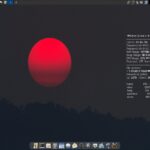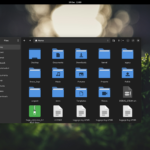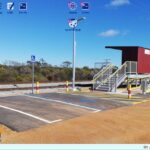4MLinux 47.0 brings new features and updates for Christmas

It’s Christmas Day, and for Linux enthusiasts, there’s an extra gift under the tree. You see, the lightweight 4MLinux has officially hit its stable release with version 47.0 (download it here).
You can now get your work done with LibreOffice 24.8 or GNOME Office, which includes tools like AbiWord 3.0.5, GIMP 2.10.38, and Gnumeric 1.12.57. Need to surf the web? Firefox 133.0 and Chrome 131.0 are here to help. Email lovers can rely on Thunderbird 128.5, while media fans can enjoy Audacious 4.4.2 for music and VLC 3.0.21 or SMPlayer 24.5.0 for video. Gamers also get a boost with support from Mesa 24.1.5 and Wine 9.21, while those needing a lightweight server solution can take advantage of BusyBox 1.36.1.
Linux-powered Serpent OS reaches its first major development milestone -- download it now!

The team behind Serpent OS has announced its Linux distro has entered alpha. The operating system, built by industry veterans with decades of experience, is a heavily engineering-led project that seeks to redefine how Linux is distributed. In the team's own words, it "represents the next evolution in Linux distributions". It offers a stateless design and atomic updates, ensuring that system changes either complete fully or roll back seamlessly if issues arise, which should guarantee reliability and stability.
The new alpha release is tailored for UEFI systems only, with secure boot support planned for future updates. For now, x86_64-v2 builds are available with GNOME and COSMIC desktop environments.
How Santa Claus could transform Christmas with Linux

Santa Claus may be magical, but even the most legendary figure could benefit from some modern technological enhancements. If he adopted the Linux kernel, which powers the world’s most flexible and open-source operating systems, the jolly old man in red could take his North Pole operations to the next level. Here are five ways Linux could transform Santa’s workshop for the better.
First, Santa could use Linux for inventory management. With millions of toys being produced, stored, and delivered annually, managing his inventory must be a logistical nightmare. Linux-based solutions like Odoo or Openbravo provide powerful tools for tracking inventory, ensuring Santa’s elves never run out of key materials like wood, plastic, or glitter.
System76 Pangolin Linux laptop gets aluminum body and 2K display upgrade

System76 has launched the latest version of its Pangolin Linux laptop, now featuring an all-aluminum body and a 16-inch 2K display. Known for catering to Linux users, the updated Pangolin combines premium build quality with powerful AMD hardware, making it suitable for a variety of workflows.
The new aluminum chassis offers improved durability and a sleek, smooth feel while maintaining the laptop’s lightweight design. System76’s focus on aesthetics and functionality shines through, giving the Pangolin a more polished look and a rigid build that alleviates concerns about flex.
Fedora Asahi Remix 41 brings Fedora Linux to Apple Silicon Macs with Vulkan 1.4 and x86 emulation

Fedora Asahi Remix 41 is now available, delivering Fedora Linux 41 to Apple Silicon Macs. This release is the result of ongoing collaboration between the Fedora Asahi SIG and the Asahi Linux project. Fedora Asahi Remix was first introduced at Flock 2023 and made its debut later in December with Fedora Asahi Remix 39.
A major highlight of this release is support for x86 and x86-64 emulation, opening the door for AAA games on Apple Silicon hardware. This is made possible with the inclusion of the new Vulkan 1.4 driver, which brings improved compatibility and performance for gaming. Beyond that, Fedora Asahi Remix 41 delivers solid device support, including high-quality audio that works right out of the box.
Why PorteuX Linux 1.8 is a faster and lighter alternative to Microsoft’s bloated Windows 11

The lightweight Linux distribution PorteuX has launched version 1.8, delivering huge updates across multiple desktop environments and a modern alternative to Windows 11. The release introduces the newly released Xfce 4.20, a sleek and efficient desktop environment, alongside updates to Cinnamon 6.4.2, GNOME 47.2, KDE 6.2.4, and LXQt 2.1.0, offering users a customizable and resource-friendly experience without the performance trade-offs often associated with Windows 11.
PorteuX 1.8 upgrades its kernel to version 6.12.5, ensuring better hardware compatibility and security. For AMD users who encounter upstream performance regressions, the kernel from version 1.7 remains available. Unlike Windows 11, which can struggle with older hardware and system requirements, PorteuX maintains its lightweight design, running smoothly even on less powerful machines.
Xfce 4.20 Linux desktop environment gets lit with experimental Wayland support and new features

The Xfce team has officially dropped version 4.20 after nearly two years of development, bringing a host of updates and experimental Wayland support to the popular lightweight desktop environment. It’s clear a lot of work went into this release, but the version number might also make you wonder -- did the developers celebrate a little too hard when naming it?
One of the headline features is experimental support for Wayland. Thanks to the new “libxfce4windowing” library, many Xfce components can now run natively on Wayland without relying on XWayland. However, this feature is far from perfect. Critical elements like workspace support and components such as Xfwm4 and Xfce4-screensaver still lack full Wayland functionality. If you’re feeling adventurous -- or maybe a bit “chill” -- you can give Wayland a try, but the team advises caution. Bugs and missing features are part of the deal for now.
Linux predictions for 2025

As we close out 2024, we Linux enthusiasts are once again looking ahead to what the future holds. While Linux has long been the unsung hero of technology, powering servers, supercomputers, and the cloud, it’s also a dominant force in the consumer space, even if many don’t realize it. With Android leading the way as the most widely used Linux-based operating system, 2025 is shaping up to be another landmark year for the open source world.
First and foremost, Linux will continue to dominate the enterprise sector. Businesses have realized the cost and flexibility benefits of moving away from proprietary systems. Linux already powers most cloud infrastructure, and as organizations look to tighten budgets, more companies will opt for open source solutions to run their operations. With major providers like AWS and Google Cloud leaning heavily on Linux, its role in the corporate world is only growing stronger.
Linux Mint 22.1 Xia beta debuts with new features and refinements

Linux Mint recently surpassed MX Linux to become the most popular distribution on DistroWatch. Now, with the arrival of Linux Mint 22.1 "Xia" in beta, users get an exciting preview of the features and improvements in the next future stable release.
This long-term support release will eventually be supported until 2029, providing a solid foundation for those seeking reliability and usability. Built on the Ubuntu 24.04 package base and powered by the Linux kernel 6.8, this beta showcases several key improvements and updates.
Windows just got smashed -- by a better OS: OpenMandriva ROME update is here to show you why Linux is better!

If you’re tired of the constant updates, system requirements, and licensing headaches that come with Windows 11, OpenMandriva ROME 24.12 might be the perfect solution. As a rolling-release Linux distribution, OpenMandriva offers users the freedom to always stay on the cutting edge without waiting for major version updates.
With this latest release, OpenMandriva delivers a combination of performance and customization, making it a solid choice for those looking to break free from Windows. The inclusion of KDE Plasma Desktop (versions 6.2.4 and 5.27.11) offers a sleek, modern interface that’s as polished as any operating system Microsoft has to offer. Add to that the flexibility Linux provides, and you’re looking at a user experience that can be tailored to your needs.
Linux Mint dethrones MX Linux as the most popular distro on DistroWatch

Linux Mint has reclaimed its position as the top-ranked Linux distribution on DistroWatch, dethroning MX Linux. The latest page hit rankings, which reflect the popularity of distributions among DistroWatch users, place Linux Mint in first place with 2,412 hits per day. MX Linux, previously the reigning champ, now sits in second with 2,280 hits.
This shift in rankings isn’t entirely surprising. Linux Mint has long been a favorite among newcomers and seasoned users alike, thanks to its user-friendly interface, stability, and robust support. Its Cinnamon desktop environment, designed for simplicity and familiarity, is often cited as one of the best for users transitioning from Windows. Meanwhile, MX Linux gained a loyal following for its lightweight design, which is perfect for older hardware or users seeking performance efficiency.
Wine 10.0-rc1 brings major Windows compatibility updates to Linux

The world of Windows application compatibility on Linux has just reached a new milestone. The Wine team has unveiled Wine 10.0-rc1, the very first release candidate for the highly anticipated Wine 10.0. This isn’t just another update -- it’s the beginning of the yearly code freeze, a crucial period where the team hones the software to perfection. Enthusiasts and developers are encouraged to put this release to the test and report any bugs, ensuring the final 10.0 version shines.
Wine 10.0-rc1 isn’t playing it safe. It brings several key upgrades and features that signal serious progress. Among the highlights, the bundled vkd3d has been updated to version 1.14, promising improved Direct3D 12 support. Meanwhile, the Mono engine has been upgraded to version 9.4.0, delivering better .NET compatibility. There’s also an initial version of a Bluetooth driver, a major leap toward better hardware interaction.
Is EasyOS Scarthgap 6.5 the perfect alternative to Windows 11 and mainstream Linux?

EasyOS Scarthgap 6.5 might just be the operating system you didn’t know you needed. As an experimental Linux distribution built with a lightweight and optimized architecture, it offers a fresh approach to desktop computing. With its innovative container technology, streamlined package management, and unique origins in Puppy Linux, EasyOS could serve as a viable alternative to both Windows 11 and traditional Linux distributions, such as Nitrux.
For those frustrated with the resource-heavy nature of Windows 11, EasyOS Scarthgap delivers a more efficient experience. Its foundation in OpenEmbedded ensures minimal bloat, while still providing access to modern applications through AppImage and Flatpak integration. And unlike mainstream Linux distributions that often mirror Windows’ complexity with package management systems like apt or yum, EasyOS simplifies things without compromising functionality.
Today is the day! Say goodbye to Microsoft Windows 11 -- Nitrux Linux 3.8.0 is the OS you've been waiting for

Let’s be honest: Windows 11 gets the job done, but for many of us, it feels more like a routine than a revelation. It’s the dependable choice we stick with because it’s what we’re used to, even when its frequent problematic updates, resource demands, and occasional hiccups make us wonder if there’s a better option out there. If you’ve been quietly considering a change but haven’t found the right fit, there’s a promising alternative worth exploring.
Nitrux offers a fresh perspective on what an operating system can be. Designed for speed and simplicity, it delivers a streamlined experience with its unique NX Desktop and lightweight foundation. It feels modern, responsive, and uncluttered -- an ideal choice for those who value efficiency and aesthetics.
Waiting for Microsoft Windows 12 is a mistake when you can upgrade to Linux today

The tech world is full of rumors about Windows 12, the supposed savior of Microsoft’s operating system lineup. The company has been tight-lipped about details, but leaks suggest it’s aiming to be a more cloud-focused, AI-driven operating system. That all sounds fancy, but here’s the truth -- waiting for Windows 12 might not be the smart play. If you’re tired of the bloat, the constant updates, and the never-ending resource demands, there’s an alternative you can embrace today: Linux.
Microsoft has spent years refining Windows, but with every iteration, it seems to get heavier, slower, and, frankly, more intrusive. Windows 12 promises new features like AI enhancements and tighter cloud integration, but do you really need an AI telling you how to use your PC? For most users, these features feel like unnecessary fluff rather than meaningful improvements. Instead of waiting for an operating system that may or may not meet your needs, you could switch to Linux -- a free, lightweight, and privacy-respecting solution that puts you in control.
© 1998-2024 BetaNews, Inc. All Rights Reserved. Privacy Policy - Cookie Policy.